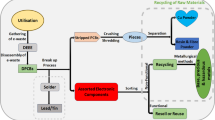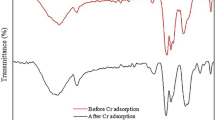Abstract
E-waste is an important secondary source of precious metals. Especially discarded printed circuit boards (PCBs) contain high concentrations of precious metals. In recent years, the bacterial leaching was more widely preferred due to its low environmental impact and cost in the recovery of these precious metals. In this study, a PCBs-adapted pure culture of A. ferrooxidans, A. thiooxidans and PCBs-adapted mixed culture of A. ferrooxidans and A. thiooxidans were used for recovery of the copper, zinc, nickel and aluminum. The effects of initial pH, inoculum bacteria and pulp density were investigated to determine the optimum conditions in bioleaching experiments. Optimum experimental conditions in mixed culture experiments were determined as 10% inoculum bacteria, 10% pulp density, 10 days leaching time, 1.8 initial pH, 30 ± 2 ℃ initial temperature, 125 µm particle size and 180 rpm stirring speed. As a result of triple experiments conducted under optimum conditions, metal recovery efficiencies for copper, nickel, zinc and aluminum were 94, 89, 88 and 59%, respectively. These results were demonstrated that the experiments with mixed culture were more effective in recovering precious metals such as copper, nickel, zinc and aluminum than others.









Similar content being viewed by others
References
Bas AD, Deveci H, Yazici EY (2013) Bioleaching of copper from low grade scrap TV circuit boards using mesophilic bacteria. Hydrometallurgy 138:65–70. https://doi.org/10.1016/j.hydromet.2013.06.15
Arshadi M, Yaghmaei S (2020) Bioleaching of basic metals from electronic waste PCBs. J Min Mech Eng 1(2):41–50. https://doi.org/10.32474/jomme.2020.01.00008
Arshadi M, Mousavi SM (2015) Multi-objective optimization of heavy metals bioleaching from discarded mobile phone PCBs: simultaneous Cu and Ni recovery using A. ferrooxidans. Sep Purif Technol 147:210–219. https://doi.org/10.1016/j.seppur.2015.04.020
Chen S, Yang Y, Liu C, Dong F, Liu B (2015) Column bioleaching copper and its kinetics of waste printed circuit boards (WPCBs) by A. ferrooxidans. Chemosphere 141:162–168. https://doi.org/10.1016/j.chemosphere.2015.06.082
Mejía-Rodríguez BJ, Bossio-Cerpa LV, Albis-Arrieta AR, Barros-Martínez AM, Medina-Buelvas AM (2018) Recovery of heavy metals from waste printed circuit boards through microbiological leaching, using consortia of acidophilic chemolithotrophic bacteria. 7th International workshop advances in cleaner production Barranquilla, Colombia, 21–22 June 2018, p 1–10
Narayanasamy M, Dhanasekaran D, Vinothini G, Thajuddin N (2018) Extraction and recovery of precious metals from electronic waste printed circuit boards by bioleaching acidophilic fungi. Int J Environ Sci Technol 15:119–132. https://doi.org/10.1007/s13762-017-1372-5
Ilyas S, Lee J, Chi R (2013) Bioleaching of metals from electronic scrap and its potential for commercial exploitation. Hydrometallurgy 131:138–143. https://doi.org/10.1016/j.hydromet.2012.11.1
Liang G, Tang J, Liu W, Zhou Q (2013) Optimizing mixed culture of two acidophiles to improve copper recovery from printed circuit boards (PCBs). J Hazard Mater 250:238–245. https://doi.org/10.1016/j.jhazmat.2013.01.077
Karwowska E, Morzuch DA, Lebkowska M, Tabernacka A, Wojtkowska M, Telepko A, Konarzewska A (2014) Bioleaching of metals from printed circuit boards supported with surfactant-producing bacteria. J Hazard Mater 264:203–210. https://doi.org/10.1016/j.jhazmat.2013.11.018
Mrazikova A, Marcincakova R, Kadukova J, Velgosova O, Balintova M (2015) Influence of used bacterial culture on zinc and aluminum bioleaching from printed circuit boards. Nova Biotech Chim 14(1):45–51
Isildar A, Rene ER, Hullebusch ED, Lens PNL (2017) Two-step leaching of valuable metals from discarded printed circuit boards, and process optimization using response surface methodology. Adv Recycl Waste Manag 2(2):1–9. https://doi.org/10.4172/2475-7675.1000132
Arshadi M, Yaghmaei S, Mousavi SM (2019) Optimal electronic waste combination for maximal recovery of Cu-Ni-Fe by A. ferrooxidans. J Clean Prod 240:118077. https://doi.org/10.1016/j.jclepro.2019.118077
Weidenhamer JD, Clement ML (2007) Leaded electronic waste is a possible source material for lead contaminated jewelry. Chemosphere 69(7):1111–1115. https://doi.org/10.1016/j.chemosphere.2007.04.023
Cui S, Zhang J (2008) Metallurgical recovery of metals from electronic waste: a review. J Hazard Mater 158:228–256. https://doi.org/10.1016/j.jhazmat.2008.02.001
Pant D, Joshi D, Upreti MK, Kotnala RK (2012) Chemical and biological extraction of metals present in E-waste: a hybrid technology. Waste Manag 32:979–990. https://doi.org/10.1016/j.wasman.2011.12.002
Pradhan JK, Kumar S (2012) Metals bioleaching from electronic waste by C. violaceum and Pseudomonas sp. Waste Manag Res 30:1151–1159. https://doi.org/10.1177/0734242X12437565
Tuncuk A, Stazi V, Akcil A, Yazici EY, Deveci H (2012) Aqueous metal recovery techniques from E-scrap: hydrometallurgy in recycling. Miner Eng 25:28–37. https://doi.org/10.1016/j.mineng.2011.09.019
Diaz-Martinez ME, Argumedo-Delira R, Sanchez-Viveros G, Alarcon A, Mendoza-Lopez R (2019) Microbial bioleaching of Ag, Au and Cu from printed circuit boards of mobile phones. Curr Microbiol 76:536–544. https://doi.org/10.1007/s00284-019-01646-3
Huang K, Guo J, Xu Z (2009) Recycling of waste printed circuit boards: a review of current technologies and treatment status in China. J Hazard Mater 164:399–408. https://doi.org/10.1016/j.jhazmat.2008.08.051
Gerayeli F, Ghojavand F, Mousavi SM, Yaghmaei S, Amiri F (2013) Screening and optimization of effective parameters in biological extraction of heavy metals from refinery spent catalysts using a thermophilic bacterium. Sep Purif Technol 118:151–161. https://doi.org/10.1016/j.seppur.2013.06.033
Arshadi M, Mousavi SM (2014) Simultaneous recovery of Ni and Cu from computer printed circuit boards using bioleaching: statistical evaluation and optimization. Bioresour Technol 174:233–242. https://doi.org/10.1016/j.biortech.2014.09.140
Mishra D, Rhee Y (2010) Current research trends of microbiological leaching for metal recovery from industrial wastes. In: Mendes-Vilas A (ed) Current research technology and education topics in applied microbiology and microbial biotechnology. World Scientific Publishing Company, Singapore, pp 1289–1296
Chen SY, Lin PL (2010) Optimization of operating parameters for the metal bioleaching process of contaminated soil. Sep Purif Technol 71:178–185. https://doi.org/10.1016/j.seppur.2009.11.018
Bhat V, Rao P, Patil Y (2012) Development of an integrated model to recover precious metals from electronic scrap: a novel strategy for e-waste management. Proc Soc Behav Sci 37:397–406. https://doi.org/10.1016/j.sbspro.2012.03.305
Bharadwaj A, Ting YP (2013) Bioleaching of spent hydrotreating catalyst by acidophilic thermophile A. brierleyi: leaching mechanism and effect of decoking. Bioresour Technol 130:673–680. https://doi.org/10.1016/j.biortech.2012.12.047
Yamanea LH, Moraesa VT, Tenórioa JAS, Espinosaa DCR (2018) Influence of bacterial adaptation on copper bioleaching from printed circuit boards. Adv Biotechnol Microbiol 9(3):555761. https://doi.org/10.19080/aibm.2018.09.555761
Lee JC, Pandey BD (2012) Bio-processing of solid wastes and secondary resources for metal extraction: a review. Waste Manag 32(1):3–18. https://doi.org/10.1016/j.wasman.2011.08.010
Mrazikova A, Marcincakova R, Kadukova J, Velgosova O (2013) Influence of bacterial culture to copper bioleaching from printed circuit boards. J Polish Miner Eng Soc 2(32):59–62
Ruan J, Qin B, Huang J (2018) Controlling measures of micro-plastic and nano pollutants: a short review of disposing waste toners. Environ Int 118:92–96. https://doi.org/10.1016/j.envint.2018.05.038
Becci A, Amato A, Fonti V, Karaj D, Beolchini F (2020) An innovative biotechnology for metal recovery from printed circuit boards. Resour Conserv Recyl 153:104549. https://doi.org/10.1016/j.resconrec.2019.104549
Zhu N, Xiang Y, Zhang T, Wu P, Dang Z, Li P, Wu J (2011) Bioleaching of metal concentrates of waste printed circuit boards by mixed culture of acidophilic bacteria. J Hazard Mater 192(2):614–619. https://doi.org/10.1016/j.jhazmat.2011.05.062
Shah MB, Tipre DR, Purohit MS, Dave SR (2015) Development of two-step process for enhanced bio-recovery of Cu-Zn-Ni from computer printed circuit boards. J Biosci Bioeng 120(2):167–173. https://doi.org/10.1016/j.jbiosc.2014.12.013
Zhao K, Gu G, Qiu G, Wang X (2017) Study on the jarosite mediated by bioleaching of pyrrhotite using A. ferrooxidans. Biosci J 33:721–729. https://doi.org/10.14393/BJ-v33n3-33824
Erust C, Akcil A, Tuncuk A, Panda S (2020) Intensified acidophilic bioleaching of multi-metals from waste printed circuit boards (WPCBs) of spent mobile phones. J Chem Technol Biotechnol 95:2272–2285. https://doi.org/10.1002/jctb.6417
Ilyas S, Ruan C, Bhatti HN, Ghauri MA, Anwar MA (2010) Column bioleaching of metals from electronic scrap. Hydrometallurgy 101:135–140. https://doi.org/10.1016/j.hydromet.2009.12.007
Mishra D, Ahn JG, Kim DJ, Chaudhury GR, Ralph DE (2009) Dissolution kinetics of spent petroleum catalyst using sulfur oxidizing acidophilic microorganisms. J Hazard Mater 167:1231–1236. https://doi.org/10.1016/j.jhazmat.2009.01.056
Faraji F, Golmohammadzadeh R, Rashchi F, Alimardani N (2018) Fungal bioleaching of WPCBs using A. niger; observation, optimization and kinetics. J Environ Manag 217:775–787. https://doi.org/10.1016/j.jenvman.2018.04.043
Mostafavi M, Mirazimi SMJ, Rashchi F, Faraji F, Mostoufi N (2018) Bioleaching and kinetic investigation of WPCBs by A. ferrooxidans, A. thiooxidans and their mixtures. JCHPE 52:81–91. https://doi.org/10.22059/jchpe.2018.255842.1227
Acknowledgements
The author is grateful to General Directorate of Mineral Research and Exploration Analysis Laboratory for all analyses.
Author information
Authors and Affiliations
Corresponding author
Ethics declarations
Conflict of interest
The author states that there is no conflict of interest.
Additional information
Publisher's Note
Springer Nature remains neutral with regard to jurisdictional claims in published maps and institutional affiliations.
Rights and permissions
About this article
Cite this article
Arslan, V. Bacterial leaching of copper, zinc, nickel and aluminum from discarded printed circuit boards using acidophilic bacteria. J Mater Cycles Waste Manag 23, 2005–2015 (2021). https://doi.org/10.1007/s10163-021-01274-9
Received:
Accepted:
Published:
Issue Date:
DOI: https://doi.org/10.1007/s10163-021-01274-9




